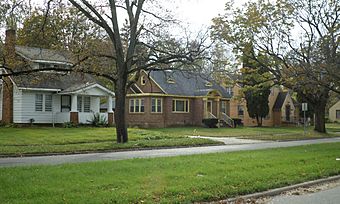Civic Park Historic District facts for kids
Quick facts for kids |
|
|
Civic Park Historic District
|
|
 |
|
| Location | Roughly bounded by Welch and Brownell Blvds., Trumbull Ave., Dupont and Dartmouth Sts., Flint, Michigan |
|---|---|
| Area | 280 acres (110 ha) |
| Built | 1919 |
| Architect | Davis, McGrath & Kiessling; William Pitkin |
| Architectural style | Late 19th And Early 20th Century American Movements, Late 19th And 20th Century Revivals, Bungalow/craftsman |
| NRHP reference No. | 79001153 |
| Added to NRHP | September 7, 1979 |
The Civic Park Historic District is a special neighborhood in Flint, Michigan. It's known for its many old homes, mostly built a long time ago for workers. This area was added to the National Register of Historic Places in 1979, which means it's an important historical place. It covers about 280 acres and is mainly a residential area.
Contents
Why Was Civic Park Built?
In 1917, the city of Flint was growing very fast. Many people were moving there to work in the busy car factories, especially for General Motors. But there weren't enough homes for everyone!
To help with this problem, some important business people in Flint started the Civic Building Association. They bought 400 acres of land. They hired William Pitkin, a landscape architect from Boston, to design the neighborhood. They also hired a New York company, Davis, McGrath & Kiessling, to create house plans.
However, their plans didn't work out at first. This was partly because of shortages during World War I.
General Motors Steps In
After the war ended, the housing shortage in Flint got even worse. More and more workers came for the booming car industry. General Motors (GM) realized that if their workers didn't have places to live, the company couldn't grow.
So, in February 1919, GM created a new company called the Modern Housing Corporation. Its goal was to build homes for GM workers. This new company bought the same land the Civic Building Association had planned to use.
They quickly announced their building plans. They used the neighborhood design by Pitkin and the house plans by Davis, McGrath & Kiessling. Construction began in April 1919.
Building a Neighborhood Fast
It was amazing how quickly Civic Park was built! In just five months, over 600 homes were finished.
General Motors encouraged its employees to buy these new homes. They even offered special deals. By January 1920, about 950 homes were built in the neighborhood. Almost all of them were filled by early spring.
However, building Civic Park cost more than expected. Also, there was an economic slowdown in 1920. Because of these reasons, GM decided not to build any more homes.
Later, in 1923, the Modern Housing Corporation did build a community center in the neighborhood. After that, new construction slowed down. Only about 60 more buildings were added over the next few decades. These included the Civic Park Community School and a couple of small shopping areas.
What Does Civic Park Look Like?
The Civic Park Historic District has about 1010 buildings. Most of these, around 950, are the original homes built between 1919 and 1920.
The lots for the houses are usually 50 feet wide and 100 feet deep. The houses themselves are mostly 1-1/2 or two stories tall. They are often bungalow style homes, which means they have a simple, cozy design. They usually have four to seven rooms.
The outside of the houses are made of brick, stucco, or wood. Most of the original homes follow one of 28 different designs created by Davis, McGrath & Kiessling. About 80 of the first homes were built by GM employees using their own designs. These homes still fit in well with the others in terms of size, color, and how they look.
Besides the homes, the neighborhood also has the Haskell Community Center, built in 1923. There's also the Civic Park Community School and two churches.

